Bài viết 12 Luật chơi cầu lông cần nắm vững cho người mới đã xuất hiện đầu tiên vào ngày unicef2014appeal.
]]>Luật cầu lông quy định chi tiết các khía cạnh kỹ thuật của môn thể thao này như kích thước sân bãi, cách tính điểm, những lỗi thường gặp, cách phát và nhận bóng… Việc nắm rõ luật chơi sẽ giúp cầu thủ tránh mắc lỗi kỹ thuật, đồng thời tăng cường khả năng chiến thuật để giành chiến thắng.
Bài viết sau đây sẽ giới thiệu chi tiết 12 luật cầu lông cơ bản mà người mới bắt đầu nên nắm rõ.
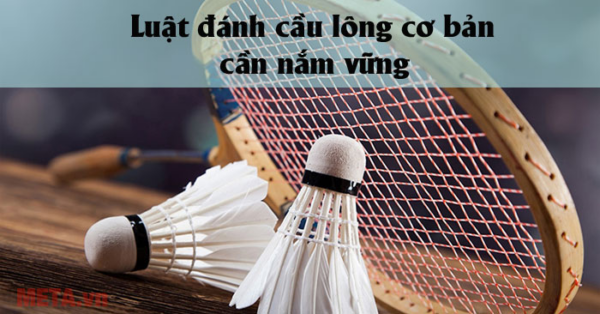
1. Kích thước sân bãi
- Sân cầu lông có hình chữ nhật, chiều dài là 13,4m, chiều rộng là 5,18m.
- Chiều cao lưới ở giữa sân là 1,55m, hai đầu sân là 1,524m.
- Sân được phân chia làm hai nửa bằng đường giữa song song với đường biên cuối sân.
- Có các đường giới hạn bên ngoài sân để xác định bóng trong hay ngoài cuộc.
2. Vợt cầu lông
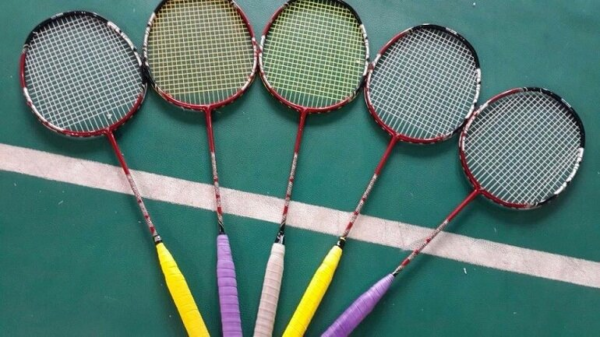
- Vợt cầu lông thường dài 26-28 inch, phần cán bằng gỗ hoặc carbon.
- Lưới vợt thường đan bằng sợi thép hoặc nhựa polyethylene.
- Người chơi có thể chọn vợt phù hợp với sở thích, kỹ thuật và chiến thuật của mình.
3. Quả cầu lông
- Quả cầu lông được làm từ 16 lông vũ, nặng từ 4,74-5,5 gam.
- Chu vi quả cầu từ 58-70mm, lõi quả thường bằng cao su hoặc nhựa tổng hợp.
- Quả cầu phải đáp ứng tiêu chuẩn về trọng lượng, kích thước để đảm bảo tính công bằng.
4. Điểm số và thắng thua
- Một set đấu được tính đến 21 điểm. Đội nào đạt trước thắng set đó.
- Nếu cả 2 bên đều đạt 20 điểm, đội dẫn trước 2 điểm sẽ thắng set.
- Nếu 20-20, cứ đấu thêm đến khi 1 bên dẫn 2 điểm mới thắng set.
- Đội thắng được quyền phát bóng ở set tiếp theo.
5. Vị trí của cầu thủ

- Mỗi cầu thủ chỉ được đứng, di chuyển ở nửa sân của mình.
- Khi phát bóng, cầu thủ phải đứng trong ô phát bóng đối diện nhau.
- Không được vào sân đối phương khi trận đấu đang diễn ra.
6. Cách thức ghi điểm
- Ghi điểm khi đối phương mắc lỗi hoặc đánh hỏng.
- Ghi điểm khi giành quyền phát bóng ở lượt tiếp theo.
- Không được ghi điểm khi mắc lỗi trong khi đánh bóng.
7. Lỗi thường gặp
- Đánh bóng sai luật (2 lần, ngoài vạch giới hạn…)
- Bóng rơi ngoài sân thi đấu.
- Cầu thủ đứng sai vị trí quy định.
- Cố ý cản trở đối phương thi đấu.
- Có hành vi vi phạm tinh thần thể thao.
8. Giao và nhận bóng
- Trước mỗi set hoặc sau mỗi điểm, người thua sẽ giao bóng cho người thắng.
- Bóng phải được đánh nhẹ xuống dưới để bay qua lưới sang phần sân đối phương.
- Bóng phải rơi trong vùng hợp lệ để được coi là phát bóng thành công.
9. Quy định khi bóng chạm lưới

- Nếu bóng chạm lưới khi đối phương chưa sẵn sàng, được quyền phát lại.
- Nếu bóng chạm vào người đối phương hoặc quần áo của anh ta, không bị coi là lỗi.
10. Thời gian nghỉ giữa các set
- Được nghỉ tối đa 60 giây giữa các set đấu.
- Được nghỉ 120 giây sau set 2 trong các trận 3 set.
11. Trang phục thi đấu
- Cầu thủ mặc trang phục thể thao thoải mái, giày vải hoặc giày chuyên dụng cầu lông.
- Màu sắc trang phục khác nhau giữa 2 đội để dễ phân biệt.
12. Tinh thần thể thao
- Tôn trọng luật chơi, trọng tài, đối thủ và khán giả.
- Không được cố ý phá đám, kéo dài thời gian thi đấu.
- Luôn thi đấu với tinh thần Fair Play.
Như vậy, với những luật chơi cầu lông cơ bản trên, hi vọng người mới có thể dễ dàng nắm rõ các quy tắc để tham gia tập luyện và thi đấu môn thể thao này một cách hiệu quả và an toàn.
Bài viết 12 Luật chơi cầu lông cần nắm vững cho người mới đã xuất hiện đầu tiên vào ngày unicef2014appeal.
]]>Bài viết Luật cầu lông đôi cơ bản bạn nên biết trong thi đấu, luyện tập đã xuất hiện đầu tiên vào ngày unicef2014appeal.
]]>
1. Sân thi đấu cầu lông đôi
- Kích thước sân cầu lông đôi giống như sân cầu lông đơn, có chiều dài 13,4m, rộng 6,1m.
- Sân được chia đôi bởi một đường song song với chiều dài sân, gọi là đường giữa sân.
- Đường giữa sân được vạch rõ ràng, rộng 40mm. Nó chia sân thành 2 phần bằng nhau.
- Hai cặp cầu thủ thi đấu ở hai phía đối diện nhau, mỗi bên nửa sân.

2. Cách bố trí vị trí của cầu thủ
- Mỗi cặp cầu thủ gồm cầu thủ phải và cầu thủ trái.
- Cầu thủ phải đứng ở ô phải của sân mình, cầu thủ trái đứng ở ô trái đối diện.
- Các cầu thủ không được đứng cùng một phía sân trong suốt trận đấu.
- Vị trí của cầu thủ chỉ thay đổi khi có sự luân phiên sân sau mỗi điểm.
3. Cách giao bóng trong cầu lông đôi
- Đội giao bóng sẽ phụ trách giao bóng đầu tiên ở điểm số 0-0.
- Đội thắng điểm sẽ giao bóng cho đội kia ở điểm tiếp theo.
- Cầu thủ giao bóng phải đứng trong ô phải khi giao bóng đầu tiên.
- Bóng được giao sang ô phải ở phía bên kia sân.
- Cầu thủ giao bóng không được chạm vạch cuối sân khi thực hiện giao bóng.
4. Cách điểm số trong cầu lông đôi
Một đội sẽ giành được điểm nếu:
- Đối thủ giao bóng sai quy định: Giao từ ngoài ô phải, giao sang ô trái đối diện, đứng chân quá vạch cuối sân.
- Đối thủ đánh bóng sai luật: Chạm bóng 2 lần liên tiếp, xâm phạm vạch giữa sân hoặc vạch biên dưới sân đối phương, đánh bóng qua lưới hoặc cột lưới mà không qua phần sân đối phương.
- Đối thủ không đánh trả lại được bóng: Bóng chạm vào người hoặc vợt của đối thủ nhưng không đánh trả lại được sang phần sân bên kia.
Điểm số được tính như sau:
- Đội ghi điểm sẽ ghi điểm của mình trước, sau đó mới đến điểm của đội bên kia.
- Điểm số luôn được gọi theo thứ tự từ 0 đến 30 (0, 2, 4, 6, 8…)
- Đội nào đạt được 21 điểm trước sẽ thắng set đấu đó.
- Nếu cả 2 đội ghi được 20 điểm, đội nào dẫn trước 2 điểm sẽ thắng (ví dụ 29-27).
- Nếu hòa 29-29, đội nào ghi điểm thứ 30 trước sẽ thắng set đấu.
- Thông thường, một trận cầu lông đôi chơi 3 set, đội nào thắng trước 2 set sẽ thắng chung cuộc.
Như vậy sẽ rõ hơn về cách tính điểm và cách để giành chiến thắng trong một set đấu cũng như cả trận đấu cầu lông đôi.
5. Cách luân phiên sân trong cầu lông đôi
- Khi một đội ghi được điểm số chẵn, các cầu thủ sẽ luân phiên vị trí sân.
- Cầu thủ đứng bên phải sẽ chuyển sang đứng bên trái và ngược lại.
- Luân phiên sân diễn ra sau mỗi lần giao bóng cho đến hết set đấu.
- Ở set tiếp theo, cầu thủ sẽ trở lại vị trí ban đầu của mình.
6. Lỗi thường gặp trong cầu lông đôi
Một số lỗi thường gặp dễ mắc phải trong cầu lông đôi bao gồm:
- Giao bóng sai luật: giao từ ngoài ô phải, giao sang ô trái đối diện, đứng chân quá vạch cuối sân.
- Chạm bóng 2 lần liên tiếp trước khi bóng sang phần sân đối phương.
- Đứng sai vị trí hoặc không luân phiên sân đúng quy định.
- Xâm phạm vạch giữa sân hoặc vạch biên dưới sân đối phương.
- Đánh bóng qua lưới hoặc cột lưới, không qua phần sân đối phương.
- Cản trở tầm nhìn của đối phương khi họ đánh bóng.
7. Một số lưu ý trong thi đấu cầu lông đôi
Để thi đấu cầu lông đôi hiệu quả, cầu thủ cần lưu ý:
- Phối hợp tốt với đồng đội, trao đổi vị trí và có tín hiệu báo cho nhau.
- Bao quát cả sân, không chỉ tập trung vào nửa sân của mình.
- Che chở cho đồng đội khi họ gặp khó khăn.
- Chủ động di chuyển và trở về vị trí để bảo vệ phần sân của mình.
- Liên tục quan sát vị trí và di chuyển của đối thủ.
- Sử dụng chiến thuật phù hợp, tấn công hoặc phòng thủ khi cần thiết.
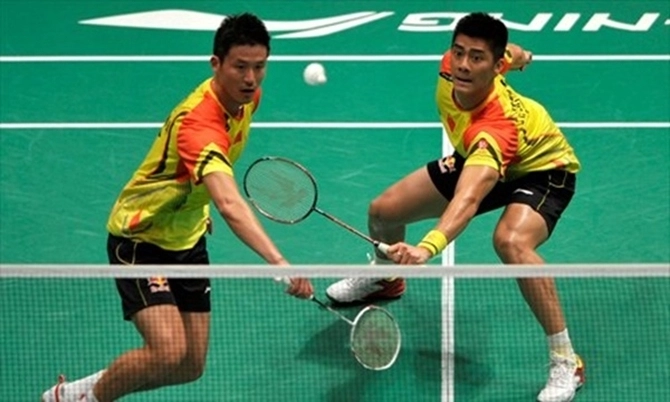
Nắm vững và tuân thủ các luật cầu lông đôi là chìa khóa giúp bạn thi đấu thành công. Hãy luyện tập thường xuyên để ăn ý cùng đồng đội và nâng cao kỹ năng chơi đôi của mình. Chúc bạn thắng nhiều trận cầu lông đôi thú vị!
Bài viết Luật cầu lông đôi cơ bản bạn nên biết trong thi đấu, luyện tập đã xuất hiện đầu tiên vào ngày unicef2014appeal.
]]>Bài viết Hướng dẫn cách chọn vợt cầu lông phù hợp nhất đã xuất hiện đầu tiên vào ngày unicef2014appeal.
]]>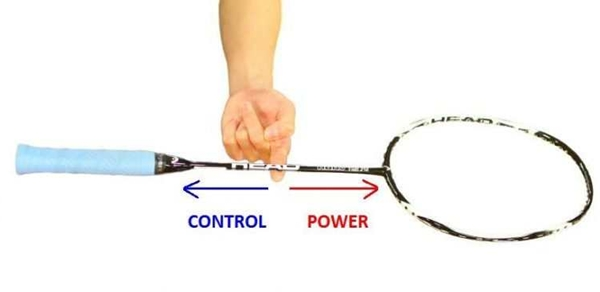
Lựa chọn vợt cầu lông dựa trên kỹ thuật và lối chơi
Điều đầu tiên cần xem xét khi mua vợt cầu lông chính là kỹ thuật và lối chơi của bản thân. Có 3 loại kỹ thuật cơ bản trong cầu lông:
- Kỹ thuật tấn công: Người chơi thích đánh bóng mạnh, nhanh và sâu vào sân đối phương.
- Kỹ thuật phòng ngự: Người chơi chủ yếu đánh bóng chậm và đẩy bóng dài, ít tấn công.
- Kỹ thuật tấn công và phòng ngự cân bằng: Vừa tấn công vừa phòng thủ.
Ngoài ra, lối chơi cũng quyết định đến sự lựa chọn vợt. Có 2 loại lối chơi cơ bản:
- Chơi 1 nửa sân: Người chơi thích điều khiển bóng ở gần vạch giữa sân.
- Chơi toàn sân: Người chơi có thể di chuyển và đánh bóng ở khắp mọi nơi trên sân.
Do đó, bạn cần xem xét kỹ kỹ thuật và lối chơi của mình để chọn mua vợt phù hợp. Vợt cầu lông sẽ có các thông số cân bằng khác nhau tùy thuộc vào kỹ thuật và lối chơi.
Lựa chọn vợt cầu lông dựa trên trình độ
Yếu tố thứ hai cần xem xét là trình độ chơi của bản thân. Có 3 trình độ cơ bản:
- Người mới bắt đầu: Chưa có kỹ năng, chỉ chơi để giải trí
- Trình độ trung bình: Đã có được một số kỹ năng nhất định rồi
- Trình độ cao: Chơi thuần thục đa số các kỹ năng và có thể thi đấu
Mỗi trình độ sẽ phù hợp với một loại vợt khác nhau. Vợt dành cho người mới bắt đầu thường nhẹ, cứng vừa phải, dễ cầm nắm và điều khiển. Vợt dành cho trình độ trung bình nặng và cứng hơn để tăng sức nảy và độ chính xác. Đối với trình độ cao thì vợt có trọng lượng và độ cân bằng tối ưu sẽ phù hợp nhất.
Do vậy, bạn cần lựa chọn loại vợt phù hợp với trình độ của mình để có trải nghiệm chơi tốt nhất. Không nên sử dụng vợt quá nặng hoặc quá nhẹ so với khả năng thực tế.
Lựa chọn vợt cầu lông dựa trên cân nặng và chiều cao
Chiều cao và cân nặng của người chơi cũng ảnh hưởng đến sự lựa chọn vợt. Những người cao to thường sẽ chọn vợt dài và nặng hơn. Ngược lại, người thấp nhỏ nên dùng vợt ngắn và nhẹ hơn để dễ thao tác.
Công thức cơ bản để chọn chiều dài vợt phù hợp là:
- Chiều cao người chơi (tính bằng cm) x 0.68 = Chiều dài lý tưởng của vợt (tính bằng inch)
Ví dụ với người cao 170cm thì chiều dài vợt phù hợp là:
170 x 0.68 = 115 inch (khoảng 67cm)
Ngoài ra, những vận động viên chuyên nghiệp thường sẽ chọn cân nặng vợt phù hợp để tối ưu khả năng điều khiển và sức nảy của bóng. Vợt nặng sẽ tạo lực nảy mạnh hơn, vợt nhẹ sẽ dễ điều khiển hơn.
Lựa chọn cân nặng đầu vợt phù hợp
Cân nặng đầu vợt cũng là yếu tố then chốt, ảnh hưởng lớn đến sức nảy và sự ổn định của cú đánh. Đầu vợt càng nặng thì lực nảy của cú đánh càng mạnh. Tuy nhiên, đầu vợt quá nặng cũng khiến vợt mất cân bằng và khó điều khiển.
Các mức cân nặng đầu vợt phổ biến như:
- Đầu nhẹ: 75 – 84 gram
- Đầu vừa: 85 – 92 gram
- Đầu nặng: 93 – 100 gram
Người mới chơi nên chọn đầu vợt nhẹ dưới 80 gram. Trình độ trung bình nên dùng đầu vợt 85-90 gram. Còn vận động viên thường dùng đầu nặng trên 90 gram.
Lựa chọn chất liệu vợt phù hợp
Hiện nay có 4 loại chất liệu vợt cầu lông phổ biến là thép, nhôm, sợi thủy tinh và carbon. Mỗi chất liệu lại có ưu nhược điểm riêng.
- Vợt thép: nặng, độ cứng cao, lực nảy mạnh mẽ. Phù hợp đánh smash và chiêu thức mạnh.
- Vợt nhôm: nhẹ, độ cân bằng tốt, độ cứng vừa phải. Thích hợp chơi nhanh nhẹn.
- Vợt sợi thủy tinh: nhẹ, độ cứng cao, độ rung ít. Phù hợp đánh nhẹ nhàng.
- Vợt carbon: cứng, bền và nhẹ. Độ rung thấp, điều khiển tốt. Lý tưởng cho các cú đánh nhanh.
Nhìn chung, vợt carbon và thép đang là xu hướng được ưa chuộng nhất hiện nay. Tuy nhiên, tùy thuộc vào sở trường của mỗi người mà có thể chọn các loại vợt khác.
Một số lưu ý khi mua vợt cầu lông

Khi mua vợt cầu lông, có một số lưu ý quan trọng sau đây giúp bạn chọn được sản phẩm phù hợp và chất lượng:
- Nên thử trực tiếp vợt trước khi mua: Việc cầm nắm và thử vung vợt thực tế sẽ giúp bạn có cảm nhận rõ hơn về độ vừa vặn, cân nặng, cảm giác cầm nắm. Điều này rất quan trọng để đảm bảo vợt phù hợp với bạn.
- Chọn mua các thương hiệu vợt uy tín: Những thương hiệu có uy tín như Yonex, Li-Ning, Victor, Ashaway… sẽ đảm bảo chất lượng tốt hơn. Tránh mua phải hàng nhái, hàng kém chất lượng.
- Chọn vợt có lớp vỏ ngoài cùng bằng da PU: Lớp vỏ PU sẽ giúp bề mặt vợt ít bị ma sát, bền hơn so với lớp vỏ cao su thông thường.
- Kiểm tra kỹ càng tay cầm vợt: Phần tay cầm cần đảm bảo lành lặn, không bị sứt mẻ, nứt vỡ. Nên kiểm tra kỹ để tránh mua phải hàng lỗi.
- Đảm bảo vợt có đủ dây và lớp bảo vệ ở cán: Vợt tốt sẽ có đủ dây và lớp bảo vệ xung quanh cán vợt. Điều này giúp đỡ việc thay thế dây và bảo vệ cán khi cần thiết.
- Nên mua thêm vỏ bọc vợt: Mua kèm vỏ bọc vợt sẽ giúp bảo quản vợt tốt hơn, tránh va đập khi di chuyển.
- Chọn cỡ vợt phù hợp: Căn cứ chiều cao, cân nặng và kỹ thuật chơi để chọn cỡ vợt cho phù hợp. Không nên mua vợt quá lớn hoặc nhỏ so với mình.
- Cân nhắc mục đích sử dụng: Nếu chơi để tập luyện thì có thể chọn vợt bình dân, còn thi đấu nên chọn loại vợt chuyên dụng hơn.
- Chọn màu vợt ưa thích: Vợt thường có nhiều màu sắc để bạn lựa chọn theo sở thích. Tuy nhiên không nên quá chú trọng vào màu sắc mà quên các yếu tố quan trọng khác.
Hy vọng với các lưu ý trên, bạn có thể chọn được cho mình một chiếc vợt cầu lông ưng ý và phù hợp nhất. Hãy lựa chọn thật kỹ lưỡng để có trải nghiệm tốt nhất khi chơi cầu lông nhé.
Như vậy, để chọn được chiếc vợt cầu lông phù hợp nhất, bạn cần xem xét kỹ càng đến kỹ thuật, trình độ, thể hình và sở thích của bản thân. Hy vọng với những kinh nghiệm trên sẽ giúp bạn lựa chọn được chiếc vợt ưng ý để thỏa sức vung vẩy trên sân cầu lông. Chúc bạn sớm tìm được “nửa kia” đồng điệu trong môn thể thao vua này nhé.
Bài viết Hướng dẫn cách chọn vợt cầu lông phù hợp nhất đã xuất hiện đầu tiên vào ngày unicef2014appeal.
]]>Bài viết 8 Luật cầu lông đơn mới nhất mà bạn cần nắm vững trong thi đấu đã xuất hiện đầu tiên vào ngày unicef2014appeal.
]]>
1. Kích thước sân thi đấu cầu lông đơn
Theo luật mới nhất, sân cầu lông đơn có kích thước 13,4m x 5,18m (chiều dài x chiều ngang). Đây là kích thước tối thiểu mà một sân thi đấu chính thức phải đạt được. Kích thước này bao gồm cả vạch biên dọc và vạch biên ngang.
Các vạch biên phải rõ ràng, có màu khác với màu sàn sân. Thông thường sử dụng màu trắng hoặc vàng cho vạch biên. Chiều rộng của vạch biên là 40mm.
2. Chiều cao lưới cầu lông đơn
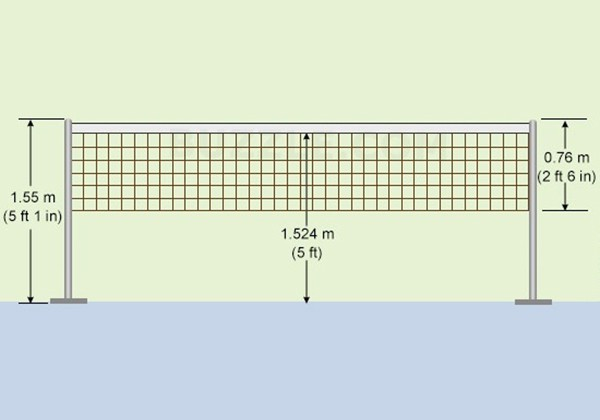
Chiều cao lưới ở giữa sân là 1,55m, hai bên mép lưới là 1,524m. Đây là chiều cao tối thiểu mà một sân thi đấu chính thức phải đạt được.
Lưới cầu lông phải được căng phẳng, không để chùng xuống dưới sức nặng của bóng bay hoặc do va đập mạnh. Chiều dày của lưới không được vượt quá 2cm.
3. Điểm số trong 1 set đấu cầu lông đơn
Theo luật mới nhất, một set đấu cầu lông đơn sẽ được tính điểm như sau:
- Điểm của người thắng: nếu thắng rally thì được 1 điểm, thắng set thì được 21 điểm (áp dụng cho cả nam và nữ).
- Điểm của người thua: mỗi lần thua rally sẽ nhận 1 điểm trừ, nếu để thua set thì sẽ có tổng điểm nhỏ hơn 21 điểm.
Nếu cả 2 bên ghi được 20 điểm, thì bên nào dẫn trước 2 điểm sẽ thắng set đó. Nếu cả 2 bên có điểm bằng nhau ở con số 20, thì bên ghi điểm cao hơn ở rally kế tiếp sẽ thắng set.
4. Số lần được phép nghỉ giữa các set đấu
Theo luật mới, các vận động viên được phép nghỉ giữa các set đấu như sau:
- Sau set 1: không giới hạn thời gian nghỉ
- Sau set 2: không quá 120 giây nghỉ
- Sau set 3: không quá 60 giây nghỉ
Nghỉ quá thời gian quy định, vận động viên sẽ bị phạt, trừ điểm số hoặc thẻ vàng cảnh cáo.
5. Hệ thống tính điểm cầu lông đơn

Hệ thống tính điểm trong cầu lông đơn được chia thành 4 giai đoạn:
- Giai đoạn 1: Điểm số từ 0-11
- Giai đoạn 2: Điểm số từ 12-16
- Giai đoạn 3: Điểm số từ 17-20
- Giai đoạn 4: Điểm số từ 21-30
Ở giai đoạn 1 và 2, nếu có số điểm bằng nhau thì bên nào ghi được điểm gần nhất sẽ giành quyền phát bóng.
Ở giai đoạn 3, nếu cả 2 bên có điểm bằng nhau thì bên nào ghi được 20 điểm trước sẽ thắng set đó.
Giai đoạn 4 là giai đoạn kết thúc 1 set, người chiến thắng sẽ là người đạt được 21 điểm trước.
6. Quy định về giờ nghỉ giữa các game trong 1 set
Theo luật mới nhất, các vận động viên được phép nghỉ 60 giây sau mỗi lần ghi được 11 điểm trong 1 set (sau game 11 điểm).
Ngoài ra, nghỉ 90 giây được cho phép 1 lần duy nhất khi một bên đạt được 6 điểm đầu tiên trong set đó.
Quy định này áp dụng cho cả đơn nam và đơn nữ. Vượt quá thời gian nghỉ, vận động viên sẽ bị phạt.
7. Hình thức xử phạt trong cầu lông đơn
Các hình thức xử phạt trong cầu lông đơn bao gồm:
- Cảnh cáo bằng lời nói
- Cảnh cáo bằng thẻ vàng: vận động viên sẽ bị trừ 1 điểm
- Cảnh cáo bằng thẻ đỏ: vận động viên sẽ bị trừ 2 điểm
- Đuổi khỏi sân thi đấu: tức là thua ngay set đấu đó
Các lỗi thường bị phạt bao gồm: chậm trễ, cố ý làm chậm trận đấu, lời nói thô tục, quấy rối đối phương, phá vỡ kỷ luật, chơi bóng bẩn…
8. Cách bốc thăm chọn sân và phát bóng
Trước khi bắt đầu trận đấu, trọng tài sẽ tiến hành bốc thăm để xác định ai sẽ chọn sân và ai sẽ phát bóng trước.
Người chiến thắng ở ván bốc thăm sẽ được quyền lựa chọn sân hoặc quyền phát bóng trước. Đối thủ sẽ làm ngược lại.
Sau mỗi lần thay sân, quyền phát bóng sẽ được chuyển cho đối phương. Điều này sẽ diễn ra liên tục cho tới hết trận đấu.
Như vậy là chúng ta đã vừa đi qua 8 luật cầu lông đơn cơ bản mà mọi vận động viên cần nắm rõ. Hy vọng những thông tin trên sẽ giúp bạn tự tin hơn khi bước vào thi đấu. Chúc bạn luôn chiến thắng và vui vẻ với môn thể thao vua này!
Bài viết 8 Luật cầu lông đơn mới nhất mà bạn cần nắm vững trong thi đấu đã xuất hiện đầu tiên vào ngày unicef2014appeal.
]]>Bài viết Hướng dẫn cách đập cầu lông mạnh và đúng kỹ thuật đã xuất hiện đầu tiên vào ngày unicef2014appeal.
]]>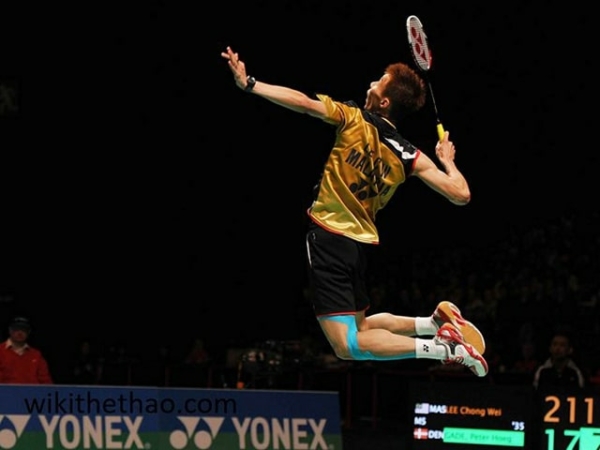
Các bước thực hiện kỹ thuật đập cầu lông
Để thực hiện được cú đập cầu lông mạnh mẽ và chuẩn xác, bạn cần luyện tập theo đúng các bước sau:
Bước 1: Nắm vợt đúng cách
- Cách nắm vợt đúng kỹ thuật sẽ giúp bạn dễ dàng điều khiển vợt, tạo lực khi đập và đỡ mỏi tay.
- Đặt ngón tay cái và ngón trỏ vào các ô lỗ trên vợt để tăng ma sát.
- Các ngón tay còn lại nắm chặt thân vợt, tay phải nắm chặt hơn tay trái.
- Luôn giữ cổ tay thẳng và căng khi cầm vợt.
Bước 2: Đứng đúng tư thế
- Đứng thuận tay cầm vợt, hai chân rộng bằng vai.
- Đặt trọng tâm cơ thể ở giữa 2 chân, đầu gối nhẹ nhàng uốn cong.
- Giữ cho thân người thẳng, mắt nhìn về phía trước.
- Đứng sát vào vạch phát cầu, sẵn sàng di chuyển nhanh nhẹn.
Bước 3: Vung vợt đúng góc độ
- Khi vung vợt lên cao, cẳng tay nên tạo góc 90 độ với cơ thể.
- Giữ cho cổ tay luôn thẳng khi vung vợt lên cao nhất.
- Vung vợt về phía sau đầu khoảng 45 độ so với thẳng đứng.
- Luôn nhìn vợt khi vung lên để chuẩn bị đập cầu.
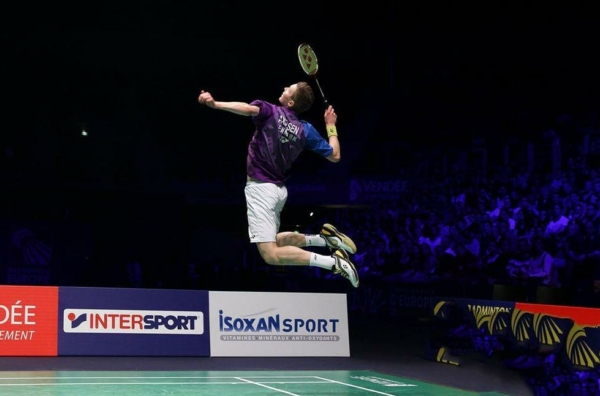
Bước 4: Tiếp xúc cầu đúng điểm
- Khi cầu bay đến, hạ thấp tay cầm vợt xuống để đập cầu ở điểm cao nhất có thể.
- Mũi vợt tiếp xúc điểm cao nhất của quả cầu, đập thẳng góc với mặt vợt.
- Điểm tiếp xúc nên ở phía trên đầu vợt để tạo sức mạnh lớn nhất.
Bước 5: Đẩy cổ tay về phía trước để tạo lực đập
- Ngay khi vợt chạm vào cầu, đẩy mạnh cổ tay về phía trước để tạo lực mạnh nhất.
- Cơ thể nghiêng về phía trước để theo đà cú đập cầu.
- Sau khi đập, vợt nên tiếp tục đà vung tới trước để tăng sức mạnh.
- Giữ cho cổ tay và cẳng tay thẳng để tránh xoắn vợt, làm mất sức đập.
Luyện tập các bài tập cơ bản để cải thiện kỹ thuật đập cầu
Để đạt được kỹ thuật đập cầu tốt, bạn cần luyện tập thường xuyên các bài tập cơ bản sau:
Bài tập 1: Đập tường
- Đứng cách tường khoảng 1m, luyện tập đập cầu liên tục lên tường.
- Tập trung vào các yếu tố: cách cầm vợt, điểm tiếp xúc, góc độ vung vợt.
- Đập đều đặn, mạnh dần lên để cảm nhận và nâng cao sức mạnh.
Bài tập 2: Đập chuyền với đối tác
- Đứng cách đối tác khoảng 5-6m, luyện chuyền và đập cầu liên tục.
- Tập trung vào độ chính xác khi đập cầu về phía đối tác.
- Tăng dần tốc độ, góc độ, chiều cao để nâng cao kỹ năng điều khiển cầu.
Bài tập 3: Đập với máy phát cầu
- Sử dụng máy phát cầu để tập luyện đập liên tục với nhiều góc độ khác nhau.
- Tập trung vào tốc độ phản ứng và sự linh hoạt của cổ tay khi đập cầu.
- Điều chỉnh tốc độ phát cầu tăng dần độ khó để rèn luyện phản xạ.
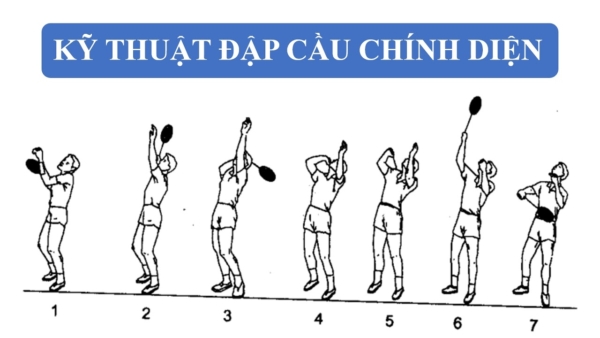
Một số lưu ý khi tập luyện đập cầu
Để đảm bảo an toàn và hiệu quả tập luyện, bạn nên lưu ý một số điểm sau:
- Luôn khởi động kỹ càng trước khi tập đập cầu để tránh chấn thương.
- Sử dụng vợt phù hợp với tay nắm để dễ dàng điều khiển.
- Bắt đầu tập từ từ rồi tăng dần cường độ để cơ thể thích nghi.
- Chú ý kỹ thuật từng bước để tránh hình thành sai cách đập.
- Đảm bảo không gian tập luyện thông thoáng, sạch sẽ.
- Luôn căng cơ tay và vai trước/sau khi tập để phòng tránh chấn thương.
Chúc bạn nhanh chóng làm chủ được các kỹ thuật đập cầu cơ bản và trở thành tay vợt cầu lông điêu luyện. Hãy nhớ rằng, sự kiên trì và nhẫn nại là chìa khóa để chinh phục môn thể thao vua này. Chúc bạn thành công!
Bài viết Hướng dẫn cách đập cầu lông mạnh và đúng kỹ thuật đã xuất hiện đầu tiên vào ngày unicef2014appeal.
]]>Bài viết 7 Cách phát cầu lông đúng kỹ thuật, hiệu quả, chính xác nhất đã xuất hiện đầu tiên vào ngày unicef2014appeal.
]]>Phát bóng tốt sẽ giúp bạn kiểm soát được hướng bay và lực bóng, tạo điều kiện thuận lợi để đánh bóng hiệu quả. Ngược lại, nếu phát bóng sai kỹ thuật, bạn sẽ khó khăn trong việc điều khiển bóng và dễ mắc lỗi.
Vậy cách phát cầu lông đúng kỹ thuật là như thế nào? Hôm nay, mình sẽ hướng dẫn cho các bạn 7 cách phát cầu lông cơ bản sau:
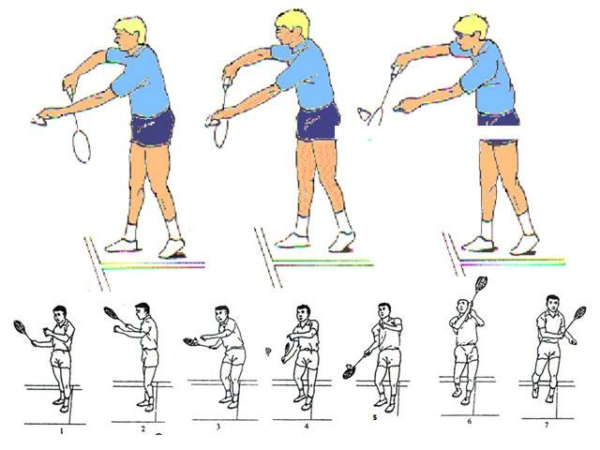
1. Đứng đúng tư thế
- Đứng thẳng, chân trái hơi nhô ra phía trước, chân phải ở phía sau. Hai chân cách nhau khoảng vai rộng, đầu gối hơi cong.
- Thân người nghiêng về phía trước khoảng 45 độ, lưng thẳng và giữ thăng bằng. Mông và vai nên thẳng hàng nhau.
- Tay cầm vợt ở trước ngực, khuỷu tay cong tạo góc 90 độ. Cổ tay linh hoạt, không căng cứng.
- Đầu ngẩng lên nhìn thẳng phía trước, tập trung vào bóng và điểm rơi của bóng.
2. Nắm vợt đúng cách
- Tay trái cầm phần cán vợt, ngón tay cái che phủ lên ngón trỏ và ngón giữa.
- Tay phải cầm phần vồ, ngón cái đặt trên còn các ngón khác nắm dưới vồ vợt.
- Tay cầm không quá chặt cũng không quá lỏng, vừa đủ để có thể vung vợt linh hoạt.
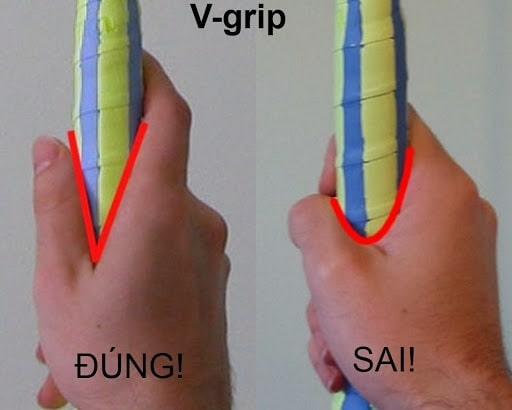
3. Di chuyển vợt đúng động tác
- Đưa vợt ra phía sau và lên cao hơn vai, khuỷu tay vẫn uốn cong góc 90 độ. Cổ tay linh hoạt.
- Vung vợt từ phía sau về phía trước theo đường cong, tăng dần tốc độ vợt. Giữ cho đầu vợt thẳng hàng với cẳng tay.
- Chú ý không vung vợt quá cao, đầu vợt không vượt quá đỉnh đầu. Điểm rơi của vợt nên ở ngang tầm ngực.
- Khi vợt chạm bóng, cổ tay phải xoay nhẹ để tạo hiệu ứng xoáy cho bóng.
4. Điểm tiếp xúc bóng vợt
- Lý tưởng nhất là vợt tiếp xúc với bóng ở phía dưới của bóng, hơi lệch về phải hoặc trái.
- Không đánh bóng ngay ở giữa vì sẽ khiến bóng bay thẳng, khó kiểm soát. Cũng không đánh vào phía trên bóng.
- Khi vợt chạm bóng, chỉ tiếp xúc trong thời gian rất ngắn, sau đó nhanh chóng rút vợt về để tránh đẩy bóng.
5. Sử dụng cơ thể đúng cách
- Chuyển trọng lượng cơ thể từ chân sau sang chân trước trong lúc vung vợt, tạo thêm lực cho cú phát bóng.
- Sau khi vung vợt, chuyển trọng lượng ngược lại từ trước ra sau để giữ thăng bằng. Đồng thời xoay mông và vai theo hướng vợt vung.
- Sử dụng sức từ cánh tay, cổ tay và xoay người để tạo lực cho cú phát. Không dùng sức từ vai hoặc lưng.
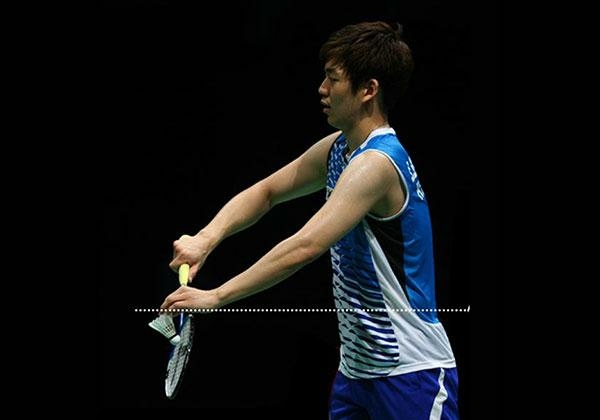
6. Phát các loại cú đánh khác nhau
- Phát cao: vung vợt lên cao hơn, tiếp xúc phía dưới bóng để bóng bay cao và xa.
- Phát bổng: vung vợt nhẹ và nhanh hơn, điểm tiếp xúc gần giữa bóng để bóng bay thấp và nhanh.
- Phát cắt: vung ngang từ trái sang phải hoặc ngược lại, làm bóng bay ngang sân đối phương.
- Thay đổi góc phát và lực bóng để phát cú đánh phù hợp với tình huống trận đấu.
7. Tập luyện nhiều để nâng cao kỹ thuật
- Tập phát bóng đều đặn, lặp lại nhiều lần các động tác cơ bản để nhuần nhuyễn kỹ thuật.
- Tăng dần tốc độ, lực và độ khó của cú phát sau mỗi buổi tập.
- Thay đổi góc độ, cao độ và hướng phát bóng để linh hoạt và đa dạng kỹ thuật.
- Tập phát xen kẽ các loại cú đánh khác nhau như phát cao, phát bổng, phát cắt…
- Tập phát bóng với huấn luyện viên để được chỉnh sửa sai sót và nâng cao trình độ.
Như vậy, mình đã hướng dẫn chi tiết 7 cách phát cầu lông cơ bản giúp các bạn nâng cao kỹ thuật phát bóng. Hy vọng bài viết sẽ giúp ích cho các bạn yêu thích môn cầu lông. Hãy linh hoạt vận dụng các kỹ thuật và luyện tập thường xuyên để có được cú phát chuẩn xác nhé!
Bài viết 7 Cách phát cầu lông đúng kỹ thuật, hiệu quả, chính xác nhất đã xuất hiện đầu tiên vào ngày unicef2014appeal.
]]>Bài viết Cách quấn cán vợt cầu lông chuẩn nhất và dễ nhất cho người mới đã xuất hiện đầu tiên vào ngày unicef2014appeal.
]]>Vì vậy, bài viết sẽ hướng dẫn từng bước cụ thể, chi tiết cách lựa chọn dụng cụ, vật tư, kỹ thuật quấn dây và những lưu ý quan trọng để quấn cán vợt thành công. Hy vọng với hướng dẫn này, bạn sẽ dễ dàng quấn cán vợt cầu lông một cách chuẩn chỉnh, vừa vặn với bàn tay của mình.
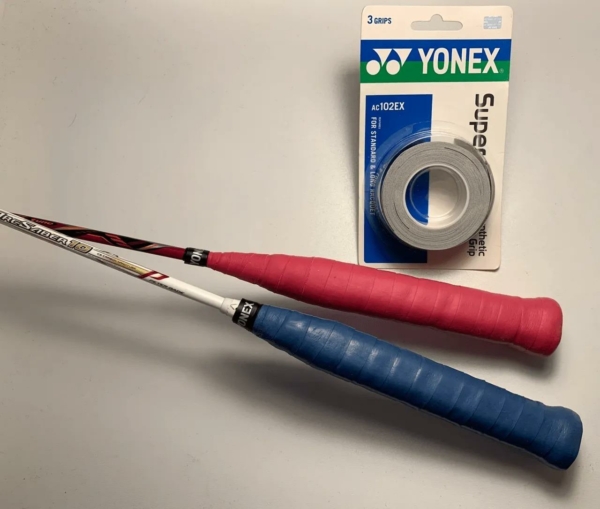
Cách quấn cán vợt cầu lông chuẩn nhất và dễ nhất cho người mới
Cách quấn cán vợt cầu lông một cách chuẩn nhất và dễ nhất, đặc biệt phù hợp cho người mới chơi.
Để bắt đầu, bạn cần chuẩn bị sẵn những dụng cụ cần thiết sau đây:
- Vợt cầu lông: Lựa chọn một cây vợt phù hợp với trình độ và sở thích của bạn. Nếu bạn là người mới chơi, nên chọn một cây vợt nhẹ và cân bằng tốt để dễ dàng cầm nắm và sử dụng.
- Cán vợt: Cán vợt thường được làm bằng gỗ hoặc composite. Đối với người mới, việc sử dụng cán vợt đã được quấn sẵn với một lớp xốp mỏng bên ngoài sẽ là sự lựa chọn tốt.
- Dây quấn cán: Dây quấn cán thường được làm bằng vải, da hoặc chất tổng hợp. Lựa chọn loại dây có độ bám tốt, đảm bảo không trơn trượt khi bạn cầm vợt.
- Kéo cắt dây: Kéo này sẽ giúp bạn cắt và gỡ dây một cách dễ dàng khi cần thiết.
- Keo dán: Sử dụng keo dán chuyên dụng để dán các đầu dây sau khi bạn đã hoàn thành việc quấn cán vợt.
- Găng tay: Đeo găng tay để bảo vệ tay khỏi bị xước khi bạn đang thực hiện quá trình quấn dây cán vợt.
Khi bạn đã sẵn sàng với tất cả dụng cụ này, bạn có thể bắt đầu quá trình quấn cán vợt cầu lông một cách hiệu quả và chính xác.
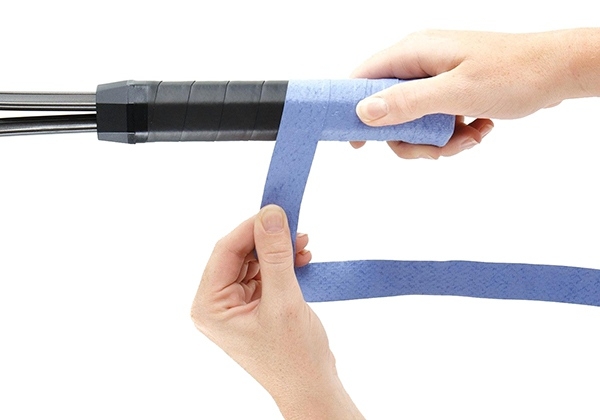
Các bước quấn cán vợt cầu lông
Bước 1: Chuẩn bị dụng cụ và vật tư
- Chuẩn bị sẵn vợt cầu lông cần quấn cán, cán vợt phù hợp kích cỡ vợt, cuộn dây quấn chất lượng tốt, kéo cắt dây, keo dán chuyên dụng, găng tay vải để bảo vệ tay.
- Kiểm tra tình trạng của các dụng cụ, đảm bảo mọi thứ đã sẵn sàng trước khi bắt đầu.
Bước 2: Lựa chọn vị trí quấn dây
- Quan sát cấu trúc của cán vợt, chọn vị trí thích hợp để bắt đầu quấn dây, thường cách phần lõi vợt 10-15cm.
- Đánh dấu vị trí bắt đầu bằng băng dính để dễ thao tác.
Bước 3: Quấn dây cán
- Căn chỉnh đầu dây thẳng gọn với mặt cán rồi bắt đầu quấn. Dùng lực vừa, quấn dây xoắn ốc đều tay xung quanh cán.
- Mỗi vòng cách nhau 0,5cm, không quấn quá chặt cũng không quá lỏng.
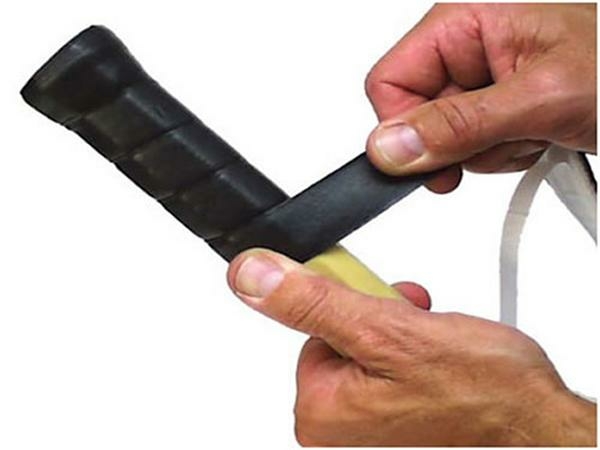
Bước 4: Kết thúc và cố định cuối dây
- Khi sắp hết cán, dừng lại, cắt bớt phần dây thừa và gỡ bỏ những sợi lỏng lẻo.
- Dán keo vào đầu cuối rồi quấn thêm 3-5 vòng nữa để cố định chặt phần đuôi dây.
Bước 5: Kiểm tra độ chắc chắn
- Sau khi quấn xong, dùng tay kéo nhẹ các vòng dây để đảm bảo chúng đã được quấn chặt.
- Nếu còn độ lỏng lẻo cần quấn lại cho đến khi đạt độ chắc chắn nhất định.
Bước 6: Cân chỉnh lớp xốp (nếu cần)
- Nếu sử dụng cán vợt chưa xốp, có thể cân chỉnh thêm một lớp xốp mỏng bên ngoài.
- Lớp xốp giúp tăng độ ma sát, cảm giác cầm nắm thoải mái và êm tay hơn.
Như vậy là chúng ta đã hoàn thành việc quấn cán vợt cầu lông. Chúc bạn thành công với cách làm đơn giản này!
Như vậy, chúng ta đã hoàn thành các bước quấn cán vợt cầu lông. Với cách làm đơn giản này, người mới có thể tự tay quấn cán vợt một cách dễ dàng. Điều quan trọng là lựa chọn loại dây phù hợp, quấn đúng kỹ thuật và kiểm tra kĩ càng trước khi sử dụng. Chúc bạn thành công với cách quấn cán vợt cầu lông đơn giản này!
Bài viết Cách quấn cán vợt cầu lông chuẩn nhất và dễ nhất cho người mới đã xuất hiện đầu tiên vào ngày unicef2014appeal.
]]>Bài viết Cách cầm vợt cầu lông đúng chuẩn cho người mới chơi đã xuất hiện đầu tiên vào ngày unicef2014appeal.
]]>Vợt cầu lông có ảnh hưởng rất lớn tới kỹ thuật và độ chính xác của cú đánh. Do đó, cách cầm vợt đúng chuẩn sẽ giúp người chơi dễ dàng làm chủ vợt và thực hiện các cú đánh một cách chuẩn xác.
Lợi ích khi cầm vợt cầu lông đúng cách
- Giúp người chơi làm chủ vợt tốt hơn, linh hoạt và dễ dàng điều khiển vợt theo ý muốn.
- Tạo sự ổn định và cân bằng cho vợt khi đánh bóng. Giúp điều khiển lực và hướng bóng chính xác hơn.
- Giảm thiểu chấn thương cổ tay do cầm vợt sai tư thế.
- Tối ưu hóa hiệu suất cú đánh nhờ độ chính xác và lực bật cao hơn.
- Rèn luyện thói quen cầm vợt đúng cách, tạo nền tảng tốt cho việc nâng cao kỹ thuật chơi cầu lông sau này.
Vì vậy, đối với người mới bắt đầu, việc học cách cầm vợt đúng chuẩn là vô cùng quan trọng. Dưới đây là các bước cơ bản nhất để cầm vợt cầu lông chuẩn cho người mới chơi.
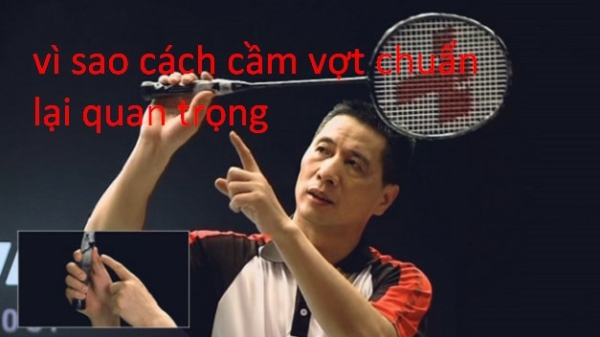
1. Chọn vợt phù hợp với bàn tay và sở thích
- Với người mới chơi nên chọn vợt cân nặng vừa phải, khoảng 80-100 gram để dễ cầm nắm và điều khiển.
- Đối với trẻ em hoặc người có bàn tay nhỏ, nên chọn vợt nhẹ hơn, khoảng 60-80 gram.
- Lưu ý chiều dài vợt phù hợp với chiều cao người chơi để dễ sử dụng.
- Chọn cán vợt có độ mềm vừa phải, đầu vợt đủ lớn để tạo cảm giác cầm nắm chắc chắn.
2. Cách cầm vợt tiêu chuẩn
- Đặt vợt ngang trên lòng bàn tay, sao cho đầu vợt ở phía dưới, cán vợt ở phía trên.
- Đặt ngón tay cái và ngón trỏ vào hai bên cán vợt để giữ chắc và điều khiển vợt.
- Các ngón tay còn lại nắm lỏng quanh cán vợt, không nắm chặt. Lòng bàn tay ôm lấy mặt dưới của cán vợt.
- Điểm móc giữa ngón tay cái và trỏ nên gần với phần đầu vợt hơn để dễ điều khiển.
- Khi cầm, các ngón tay giữ thẳng và tự nhiên, không quặp quá chặt lại.
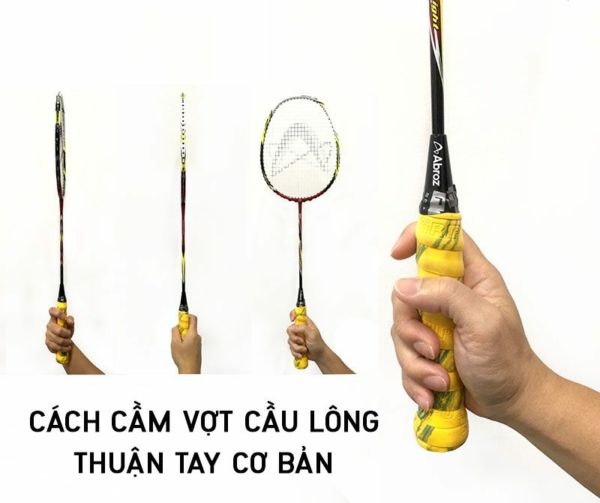
3. Điều chỉnh tay cầm cho phù hợp
- Người mới chơi nên điều chỉnh tay cầm sao cho thoải mái nhất, không gò bó.
- Nếu thuận tay phải thì dùng cách cầm tiêu chuẩn ở trên, còn thuận tay trái có thể đổi ngược lại.
- Nếu cảm thấy khó cầm ngón út và ngón đeo nhẫn vào cán vợt, có thể thả lỏng hoặc không dùng 2 ngón này cầm vợt.
- Điều chỉnh khoảng cách ngón tay cái và trỏ sao cho vừa vặn với kích thước bàn tay.
- Hãy thử nghiệm nhiều cách cầm khác nhau để tìm tư thế phù hợp và thoải mái nhất.
4. Luyện tập cầm vợt đúng cách
- Sau khi tìm được cách cầm vợt phù hợp, hãy dành thời gian luyện tập thường xuyên để tạo thói quen.
- Cố gắng cầm theo cùng một cách mỗi lần chơi để tay và não bộ nhớ và thích nghi nhanh hơn.
- Có thể luyện tập cầm vợt chuẩn ở nhà trước khi ra sân tập luyện.
- Hình thành thói quen kiểm tra tay cầm trước mỗi lần chơi để đảm bảo cầm đúng và chuẩn.
- Nhờ huấn luyện viên hoặc người chơi kinh nghiệm kiểm tra và điều chỉnh tay cầm để cải thiện dần.
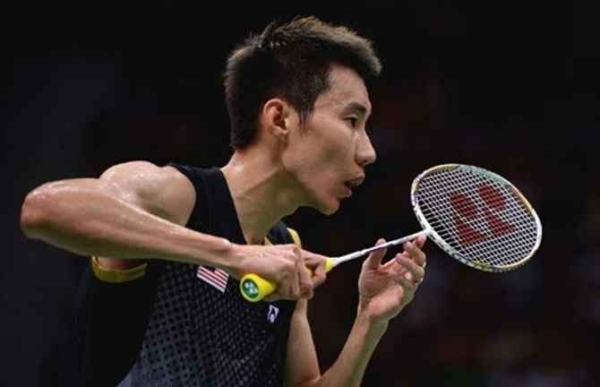
Như vậy, cách cầm vợt cầu lông chuẩn cho người mới chơi không quá phức tạp. Chỉ cần lựa chọn vợt phù hợp, cầm theo tư thế tiêu chuẩn rồi điều chỉnh sao cho thoải mái là có thể bắt đầu luyện tập. Với sự kiên trì, bạn sẽ sớm làm quen và thành thục cách cầm vợt đúng chuẩn, từ đó nâng cao trình độ chơi cầu lông một cách nhanh chóng. Chúc bạn thành công!
Bài viết Cách cầm vợt cầu lông đúng chuẩn cho người mới chơi đã xuất hiện đầu tiên vào ngày unicef2014appeal.
]]>Bài viết 7 Cách đánh cầu lông cơ bản cho người mới bắt đầu đã xuất hiện đầu tiên vào ngày unicef2014appeal.
]]>Thông qua bài viết này, chúng tôi sẽ hướng dẫn chi tiết 7 cách đánh cầu lông cơ bản để người mới bắt đầu có thể nắm vững các kỹ năng, tự tin thi đấu và có những trận cầu lông thú vị.
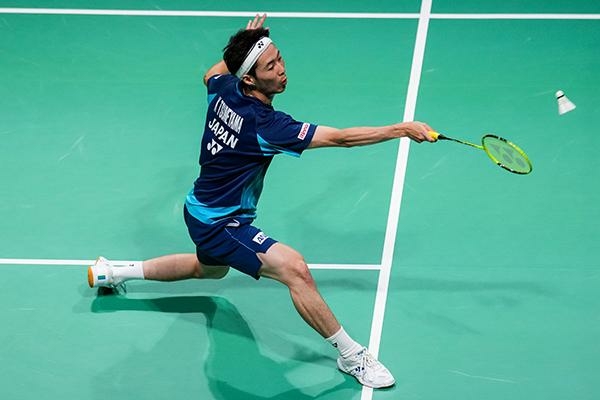
1. Cách cầm vợt cầu lông chuẩn
- Cách cầm vợt đúng là nền tảng quan trọng để có thể vung vợt và điều khiển bóng một cách chính xác. Cụ thể:
- Dùng 3 ngón tay giữa để cầm phần cán vợt ở vị trí giữa. 3 ngón gồm ngón trỏ, ngón giữa và ngón áp út.
- Lòng bàn tay hướng xuống dưới, các ngón tay khép nhẹ và ôm lấy cán vợt. Ngón cái và ngón út khép vào trong để tạo độ cứng cần thiết.
- Tay còn lại nắm vào phần dưới của cán vợt, gần sát mặt vợt. Tay này giúp điều khiển hướng và lực khi vung.
- Giữ chặt vợt nhưng không được quá cứng. Tay vẫn phải thoải mái để có thể vung vợt linh hoạt.
- Điều chỉnh vị trí 2 tay sao cho vợt được cân bằng, tránh tình trạng cầm quá cao hoặc quá thấp so với tâm điểm của cán vợt.
2. Cách đứng đúng tư thế trên sân cầu lông
- Đứng ở giữa sân, 2 chân rộng bằng vai hoặc hơi rộng hơn vai một chút.
- Chân trái ở phía trước, chân phải ở phía sau. Đầu gối hơi cong, thân người nghiêng về phía trước.
- Giữ thăng bằng tốt. Mắt nhìn thẳng phía trước. Đầu và vai giữ thả lỏng.
- Tập trung cao độ vào quả cầu. Luôn trong tư thế sẵn sàng di chuyển nhanh theo hướng bay của cầu.
- Trọng lượng cơ thể dồn vào chân trước, sẵn sàng bứt tốc.
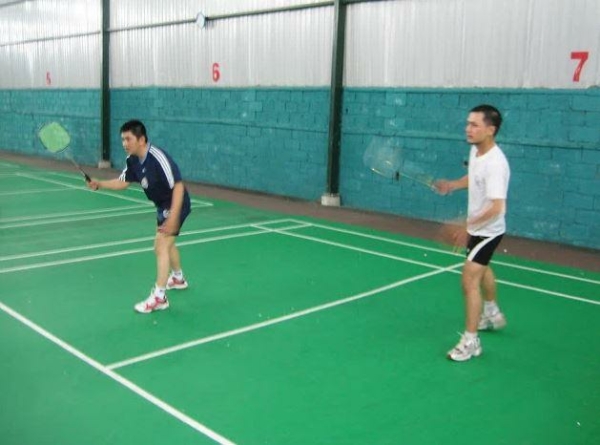
3. Cách vung vợt cơ bản đúng kỹ thuật
- Giữ vợt thẳng đứng, khuỷu tay cong khoảng 90 độ, phía sau lưng.
- Vung vợt lên phía trước theo đường vòng cung rộng. Cổ tay phải linh hoạt.
- Chú ý điểm rơi của vợt là phía trước cơ thể, không được vung lên quá cao.
- Khi vợt chạm bóng, cần vặn nhẹ cổ tay để tạo lực, làm bóng bay nhanh và sâu vào sân đối phương.
- Giữ vững tư thế, trọng tâm cơ thể dồn vào chân trước để giữ thăng bằng khi vung.
4. Cách phòng thủ cơ bản trong cầu lông
- Đứng giữa sân, 2 chân rộng bằng vai. Đầu gối hơi cong, thân người hơi nghiêng về phía trước.
- Giơ vợt lên cao ngang tầm ngực, mặt vợt hướng về phía đối phương.
- Theo dõi quả cầu, di chuyển vợt nhanh nhẹn để đập trả bóng.
- Sử dụng cạnh hoặc mặt vợt để đập cầu. Không dùng cán vợt.
- Thực hiện động tác nhanh nhẹn, không cứng nhắc. Giữ vững tư thế.
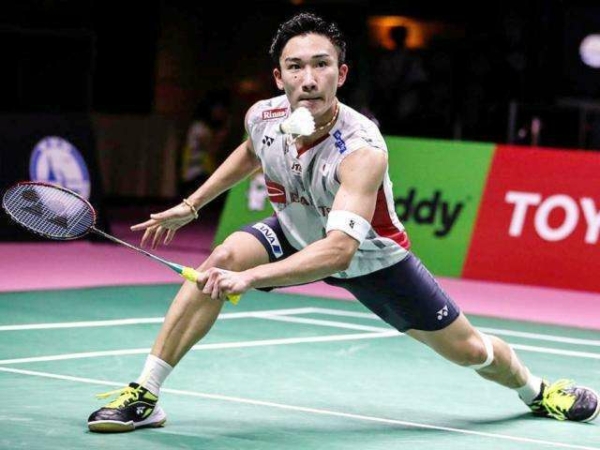
5. Cách thực hiện cú Smash cơ bản
- Đứng sát mạng lưới, chuẩn bị đánh bóng bổng cao từ phía đối phương.
- Vung vợt mạnh tay, hướng từ trên xuống dưới, nhằm đập mạnh bóng xuống sân đối phương.
- Điểm rơi của vợt ở bên dưới cơ thể, trước người. Không đánh vợt quá cao.
- Cổ tay phải vặn mạnh vào thời điểm chạm bóng để tạo lực đập bóng lớn.
- Sau khi đánh, tiếp đất bằng chân trước. Dồn trọng lượng vào chân trước để giữ thăng bằng.
6. Cách di chuyển đúng kỹ thuật trên sân
- Luôn giữ thăng bằng, sẵn sàng di chuyển nhanh theo hướng bay của cầu.
- Sử dụng các bước chạy nhỏ, nhanh nhẹn. Không bước quá dài.
- Mắt luôn hướng về phía trước, quan sát bóng và đối thủ.
- Chuyển trọng lượng cơ thể từ chân này sang chân kia một cách linh hoạt.
- Không bao giờ quay lưng lại với đối phương khi di chuyển. Luôn hướng mặt về phía trước.
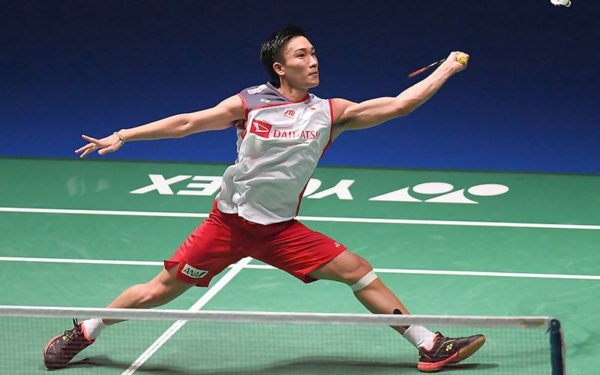
7. Một số lưu ý quan trọng khi chơi cầu lông
- Luôn khởi động và giãn cơ trước/sau khi chơi để phòng tránh chấn thương.
- Tập trung tối đa khi thi đấu. Hạn chế nói chuyện khi đấu để tránh mất tập trung.
- Tuân thủ luật thi đấu và tinh thần thể thao, fair play.
- Tăng cường luyện tập và nâng cao trình độ từ từ. Không nên cố sức quá sớm dẫn đến chấn thương.
- Nghỉ ngơi và bổ sung nước sau các hiệp đấu để phục hồi thể lực tốt nhất.
Như vậy, với 7 cách đánh cầu lông cơ bản trên, hy vọng người mới bắt đầu có thể nắm vững các kỹ thuật và tự tin hơn khi bước vào môn thể thao vừa rèn luyện thể chất vừa rèn luyện tinh thần này. Hãy kiên trì rèn luyện để chơi cầu lông ngày càng giỏi nhé!
Bài viết 7 Cách đánh cầu lông cơ bản cho người mới bắt đầu đã xuất hiện đầu tiên vào ngày unicef2014appeal.
]]>Bài viết Trọng lượng và kích thước quả bóng chuyền tiêu chuẩn đã xuất hiện đầu tiên vào ngày unicef2014appeal.
]]>Để chơi được bóng chuyền, bạn cần có một số dụng cụ thiết yếu, quan trọng nhất là quả bóng. Bóng chuyền có kích thước và trọng lượng nhất định để phù hợp với luật chơi của môn thể thao này.
Kích thước quả bóng chuyền tiêu chuẩn
Theo quy định của Liên đoàn Bóng chuyền Quốc tế (FIVB), bóng chuyền tiêu chuẩn phải có các kích thước sau:
- Chu vi: 65-67 cm
- Đường kính: 25-27 cm
Đối với các giải đấu chuyên nghiệp, FIVB yêu cầu sử dụng bóng có chu vi 66-67 cm và đường kính 25,6-26,4 cm.
Các quả bóng chuyền thường được làm bằng da tổng hợp hoặc da thật, bên trong có ruột bóng làm bằng cao su hoặc vật liệu tổng hợp. Điều này giúp bóng có độ đàn hồi và bay tốt hơn.
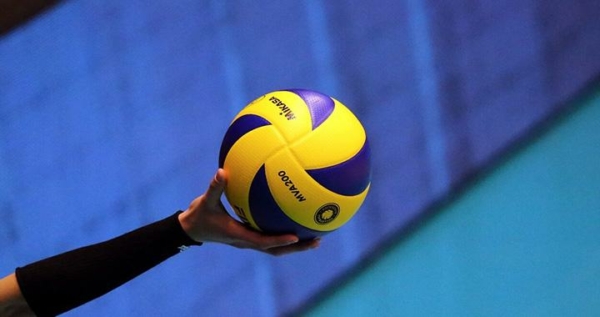
Trọng lượng quả bóng chuyền tiêu chuẩn
Ngoài kích thước, trọng lượng của quả bóng chuyền cũng được quy định cụ thể, phụ thuộc vào giới tính và độ tuổi của người chơi:
- Đối với nam trưởng thành: 260-280 g
- Đối với nữ trưởng thành: 220-240 g
- Với trẻ em dưới 12 tuổi: 210-230 g
Quy định về kích thước và trọng lượng nhằm tạo sự công bằng cho các vận động viên. Bóng nhẹ hơn sẽ phù hợp với sức khỏe và thể lực của phụ nữ và trẻ em.
Trọng lượng nặng hơn ở bóng dùng cho nam giúp bóng bay xa và mạnh hơn. Tuy nhiên, vẫn phải đảm bảo an toàn, dễ kiểm soát cho người chơi.
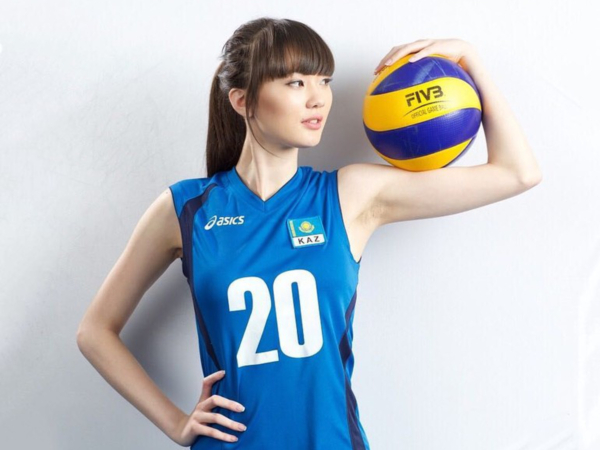
Vì sao phải tuân thủ tiêu chuẩn nghiêm ngặt?
Việc tuân thủ nghiêm ngặt các tiêu chuẩn về kích cỡ và trọng lượng bóng chuyền là rất cần thiết, vì một số lý do:
- Để đảm bảo tính công bằng: nếu kích thước và trọng lượng khác nhau sẽ tạo lợi thế không công bằng giữa các đội hoặc vận động viên.
- Giúp các vận động viên quen với một chuẩn bóng nhất định, từ đó phát huy tốt kỹ thuật của họ. Bóng quá to hoặc quá nặng sẽ khó khống chế.
- Để bảo vệ sức khỏe vận động viên, nhất là với trẻ em và phụ nữ. Bóng quá nặng có thể gây chấn thương.
- Thống nhất kích thước sân bãi, chiều cao lưới, khoảng cách giữa các vận động viên,…cho phù hợp với bóng.
- Tiện cho việc tổ chức các giải đấu cấp khu vực, quốc gia và quốc tế. Các đội có thể dùng chung một loại bóng thi đấu.
Như vậy, việc tuân thủ tiêu chuẩn về bóng chuyền là vô cùng quan trọng. Chúng giúp tạo nên sự công bằng và an toàn cho các vận động viên. Đồng thời cũng thúc đẩy sự phát triển của môn thể thao này.
Mua bóng chuyền ở đâu?
Bóng chuyền tiêu chuẩn có thể mua ở các cửa hàng thể thao lớn hoặc trên các website thương mại điện tử như Lazada, Shopee, Tiki,…
Một số thương hiệu bóng chuyền nổi tiếng gồm Molten, Mikasa, Wilson,…đã qua kiểm định chất lượng và đạt tiêu chuẩn quốc tế. Giá bóng thường rơi vào khoảng 200.000 – 700.000 đồng tùy loại.
Ngoài ra, nhiều công ty nhập khẩu cũng phân phối các loại bóng chuyền chính hãng giá tốt. Bạn có thể tham khảo và chọn mua một quả bóng ưng ý.
Trên đây là một số chia sẻ về kích thước và trọng lượng của quả bóng chuyền tiêu chuẩn. Hy vọng những thông tin này có thể giúp ích cho bạn trong việc lựa chọn và sử dụng bóng chuyền đúng cách. Chúc bạn thành công!
Bài viết Trọng lượng và kích thước quả bóng chuyền tiêu chuẩn đã xuất hiện đầu tiên vào ngày unicef2014appeal.
]]>